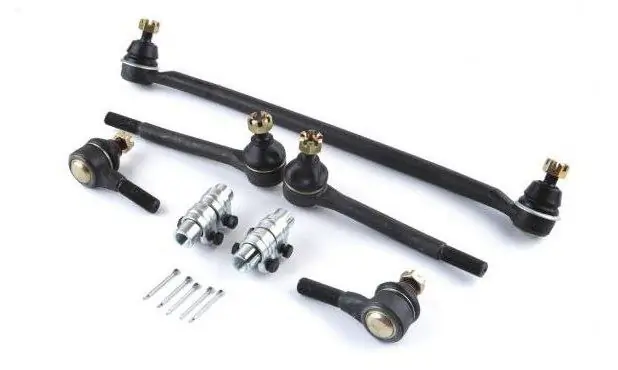2026 Author: Erin Ralphs | [email protected]. Last modified: 2025-01-22 21:14:09
One of the main systems of the car is the steering, which is a set of mechanisms that synchronize the angle of rotation of the wheels of the main axle and the position of the steering wheel. The steering requires regular diagnostics and technical inspection, the implementation of which depends on the design features and type of assembly.
Assign steering
While driving, the driver is obliged to control the position of the vehicle relative to other road users and the allocated lane. To change the route or perform maneuvers, the driving mode is changed using the brake system and steering.
Elimination of side slip and stabilization of the steering wheels is carried out by means of a steering gear, which returns the car to a straight line of movement after the driver stops applying force to the steering wheel.

Steering device
The steering system device includes the followingitems:
- Steering wheel. Used to control the vehicle and adjust the direction of its movement. Modern models are equipped with multifunction steering wheels equipped with an airbag.
- Steering column. It transmits forces from the steering wheel to the steering mechanism and is represented by a shaft with articulated joints. Electric or mechanical locking and folding systems guarantee the vehicle's theft protection and safety. The steering column is equipped with an ignition lock, windshield wiper and lighting controls.
- The steering mechanism transmits to the wheel drive the forces created by the driver through the rotation of the steering wheel. It is represented by a gearbox with a certain gear ratio. The cardan shaft connects the steering gear to the steering column.
- The steering gear is structurally represented by levers, tips and steering rods that transmit the steering forces to the steering knuckles.
- Power steering - makes driving easier and increases the force transmitted to the drive from the steering wheel.
- Additional structural elements - electronic systems, shock absorbers.
The steering and suspension of a car are closely related: the degree of response of the vehicle to the rotation of the steering wheel depends on the height and stiffness of the suspension.

Types of steering system
The steering mechanism can be divided into several categories depending on the type of gearbox:
- Rack. It is considered the most common and is installed on cars. The mechanism with the simplest design and characterized by maximum efficiency. The downside is sensitivity to shock loads that occur when the vehicle is operated in difficult road conditions.
- Worm. Provides a large angle of rotation of the wheels and good maneuverability of the car. The movement is virtually shock resistant, but more expensive to manufacture.
- Screw. By the principle of operation, it is similar to the worm type, but it has a high efficiency and creates great efforts.
Classification by amplifier type
Steering systems are divided into several types depending on the type of amplifier installed:
- Hydraulic (GUR). The advantage is the simplicity of design and compact dimensions. Hydraulic steering systems are among the most common and are installed on most modern cars. The disadvantage of this control is the need to regulate the level of the working fluid.
- Electric (EUR). Progressive control system. The amplifier ensures the reliability of the system, fuel economy, the ability to control the car without the involvement of the driver and facilitates control settings.
- Electrohydraulic (EGUR). According to the principle of operation, the system is similar to a hydraulic booster. The main difference is the functioning of the pump, which is not driven by the car's internal combustion engine, but by an electric motor.
Additional systems
Steeringcontrol of modern cars are equipped with various systems:
- Active Steering (AFS). Adjusts the value of the gear ratio depending on the speed of movement. Guarantees safe and stable driving on slippery roads by correcting the steering angle.
- Dynamic steering. It functions similarly to the active system, however, the place of the planetary gearbox in the design is occupied by an electric motor.
- Adaptive steering. A feature is the absence of a rigid connection between the wheels and the steering wheel of the car.

Steering Requirements
According to the standards, the steering system has the following requirements:
- Providing the necessary trajectory of movement according to the parameters of maneuverability, stability and agility.
- The force applied to the steering wheel must not exceed the specified values.
- The number of turns of the steering wheel from the standard position to any of the extreme positions must comply with the norms.
- The ability to drive the car must be maintained after the failure of the amplifier.
The normal functioning of the steering system is determined by another parameter - the total backlash, which implies the angle of the steering wheel before the wheels turn.
The allowable total play in the steering must comply with accepted standards:
- For minibuses and cars - 10 degrees.
- For buses and similarvehicles - 20 degrees.
- For trucks - 25 degrees.

Features of right-hand drive and left-hand drive
Depending on the legislation of specific countries and the type of vehicle, modern cars are divided into right-hand drive and left-hand drive. Accordingly, the steering wheel can be located both on the right and on the left. For example, VAZ steering systems are left-hand drive.
Mechanisms differ not only in the position of the steering wheel, but also in the gearbox, which is adapted to a specific connection side. Despite this, it is possible to convert right-hand drive to left-hand drive.
Some types of construction equipment are equipped with hydrostatic steering, which ensures that the steering wheel placement is independent of other elements. Such a steering system does not have a mechanical connection between the steering wheel and the drive, and the wheels turn using a power cylinder controlled by a metering pump.
Compared to standard mechanisms, hydrostatic steering requires little effort to turn, has no backlash, and its layout allows for arbitrary arrangement of structural elements.
Accordingly, hydrostatic control provides both left-hand and right-hand control. Thanks to this, the system can be installed on special vehicles.

Causes of system failures
HelmsmanThe mechanism, like any other elements, is prone to breakage. There can be several reasons for malfunctions:
- Aggressive driving style, harsh driving conditions.
- Poor quality pistes coverage.
- Using non-genuine parts.
- Untimely maintenance.
- Carrying out repairs by incompetent craftsmen.
- Equipment exceeding its useful life.
Problems that occur with the braking or steering systems of the car can lead to an emergency on the road.
Types of malfunctions and their symptoms
The steering system of vehicles can fail over time. The appearance of breakdowns is accompanied by certain signs:
- When external knocks appear, the steering hinge changes.
- Steering wheel vibration is eliminated by proper wheel alignment.
- When the wheels beat, their settings change, steering rod components or column bearings are replaced.
- Tie rod ends change when play exceeds 10 degrees.

Diagnosis and maintenance
To eliminate problems with the steering system of a car, it is important not only to carry out regular maintenance, but also to diagnose the main components and assemblies.
Be sure to check the backlash with a special device - a backlash meter. It is advisable to check the system for jamming.
During technical inspectionthe condition of the hydraulic booster is assessed. If the oil level in the system is lower than required, then it is topped up. The steering crankcase is diagnosed, the tightening level of the wedges, pins, cotter pins, the latter after lubrication of the steering rod.
Subsequent technical inspections imply a set of diagnostic procedures implemented using special equipment. Repair of the steering system is best done in service centers where professionals work.
Masters should check the total backlash of the mechanism with a backlash meter. For passenger cars, it should be 10 degrees.

Importance of correct steering operation
The vehicle is considered a source of increased danger, and therefore, in order to prevent accidents, the car owner is required to maintain the car in good condition and regularly monitor the technical condition.
The main purpose of the steering system is to provide the ability to control the machine. A working mechanism guarantees safe and confident movement, which is important not only for the driver, but also for passengers.
The traffic rules state that it is forbidden to continue driving and operate a car with a failed steering system, in the presence of play, oil leaks from the rack.
A good control system has a significant impact on the condition of the car's rubber: tire wear must be even to avoid loss of control, throwing off the track while driving and the occurrence of malfunctionsother components and assemblies of the vehicle.
Steering is one of the most important design elements of a modern vehicle and requires regular monitoring of its condition and competent technical inspection and repair and restoration work. It is forbidden to drive a car with a failed steering system in order to avoid accidents on the highway and to maintain the safety of the driver, passengers and other road users.
Recommended:
Types of car tinting. Car window tinting: types. Toning: types of films

Everyone knows that different types of tinting make the car more modern and stylish. In particular, dimming the windows in a car is the most popular and popular way of external tuning. The whole advantage of such modernization lies in its simplicity and relatively low cost of the procedure
Steering trapezoid: device, purpose. Vehicle steering

The steering trapezoid on the "seven" consists of tips and central thrust. This mechanism ensures smooth and synchronous turning of both front wheels. The forces applied by the driver to the steering wheel are transmitted through the column to the gearbox. The latter allows you to convert the movement using a worm gear and rotates the steering knuckles through the steering rods
What type of car is the best. The main types of cars and trucks. Car fuel types

Life in the modern world is unimaginable without various vehicles. They surround us everywhere, almost no industry can do without transport services. Depending on what type of car, the functionality of the means of transportation and transportation will be different
Car air conditioning system: diagnostics, repair, flushing, cleaning, system pressure. How to flush a car's air conditioning system?

The warm season is accompanied by frequent requests from car owners to service shops for such a service as diagnostics of the car's air conditioning system, as well as troubleshooting. We will understand the reasons for this phenomenon
Steering technique: turning the steering wheel when turning. Creaking, crunching when turning the steering wheel, what do they mean

Few drivers think about, for example, how correctly they hold the steering wheel, considering this an unimportant nuance that does not affect the quality of driving; Or what should be the turn of the steering wheel when turning. In fact, there is a whole technique for handling the steering wheel

